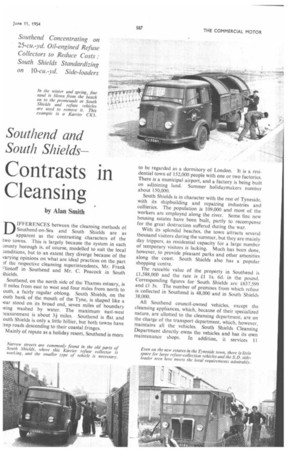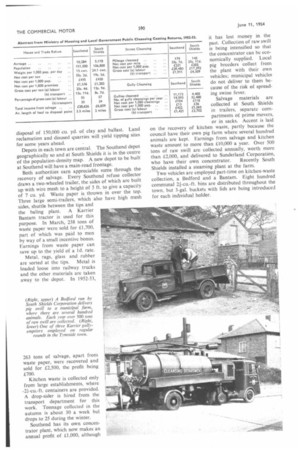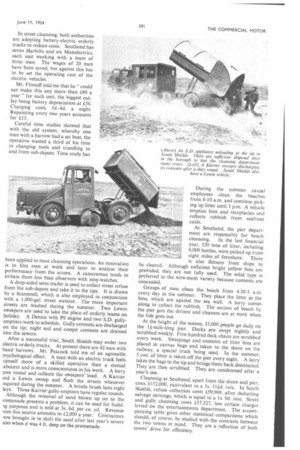Contrasts in Cleansing
Page 73

Page 74

Page 75

Page 76

Page 77

If you've noticed an error in this article please click here to report it so we can fix it.
Southend and
South Shields—
Southend Concentrating on 25-cu.-yd. Oil-engined Refuse Collectors to Reduce Costs South Shields Standardizing on 10-cu.-yd. Side-loaders
by Alan Smith
DIFFERENCES between the cleansing methods of Southend-on-Sea and South Shields are as apparent as the contrasting characters of the two towns. This is largely because the system in each county borough is, of course, modelled to suit the local :onditions, but to an extent they diverge because of the varying opinions on what are ideal practices on the part 3f the respective cleansing superintendents, Mr. Frank 9intoff in Southend and Mr. C. Peacock in South ihields.
Southend, on the north side of the Thames estuary, is 0 miles from east to west and four miles from north to outh, a fairly regular oblong. South Shields, on the outh bank of the mouth of the Tyne, is shaped like a ear stood on its broad end, seven miles of boundary ieing washed by water. The maximum east-west wasurement is about 3i miles. Southend is flat and outh Shields is only a little hillier, but both towns have teep roads descending to their coastal fringes.
Mainly of repute as a holiday resort, Southend is more to be regarded as a dormitory of London. It is a residential town of 152,000 people with one or two factories. There is a municipal airport, and a factory is being built on adjoining land. Summer holidaymakers number about 150,000.
South Shields is in character with the rest of Tyneside, with its shipbuilding and repairing industries and collieries. The population is 109,000 and most of the workers are employed along the river, Some fine new housing estates have been built, partly to recompense for the great destruction suffered during the war.
With its splendid beaches, the town attracts several thousand visitors during the summer, but they are mainly day trippers, as residential capacity for a large number of temporary visitors is lacking, Much has been done, however, to provide pleasant parks and other amenities along the coast. South Shields also has a popular shopping centre.
The rateable value of the property in Southend is £1,588,000 and the rate is £1 Is. 6d, in the pound. Corresponding figures for South Shields are £637,599 and it 3s. The number of premises from which refuse is collected in Southend is 48,000 and in South Shields 38,000.
All Southend council-owned vehicles, except the cleansing appliances, which, because of their specialized nature, are allotted to the cleansing department, are on the charge of the transport department, which, however, maintains all the vehicles. South Shields Cleansing Department directly owns the vehicles and has its own maintenance shops. In addition, it services 11 ambulances and the vehicles of the weights and measures department. The Southend refuse-collection fleet comprises seven Dennis Paxit 25-cu.-yd. rear-loaders, all but one fitted with Perkins P6 engines, and seven Karrier CK3 and six S.D. 10-cu.-yd side-loaders. The Paxits have been introduced fairly quickly in recent years. As two were put into service, three 10-cu.-yd. appliances. were withdrawn. The smaller vehicles worked on a relay system whereby three vehicles were served by two teams of loaders. When they were abandoned, each route was halved and a 25-cu.-yd. appliance was placed on each half, with one team per vehicle. There are six men in each team, but teams of four are being tried.
The result of using the Paxits is that oil-engine fuel economy is realized, the greater capacity entails only two or three runs to the tip instead of five or six a day, and altogether substantial savings in fuel costs per hour are made. Because of this, three petrol vehicles are due for early replacement by two big oilers, although they are by no means nearly worn out.
Southend's Costs
The figures below were given me by Mr. Flintoff, who is the author of " Municipal Cleansing Practice," the standard work on the subject. The Dennis vehicles are depreciated over 10 years and the smaller appliances over seven. The yearly allotment on this account for a Paxit is £241, for a CK3 £149 and an S.D. £194, respective hourly figures being 2s., Is. 3d. and Is. 7id.
Running costs, to which depreciation and establishment charges are additional, are 8s. an hour for a Dennis and 9s. or more for a smaller petrol vehicle. Hourly fuel costs are Is. 3d. for an oiler and 2s. 6d. for a petrol appliance.
Substantial economies have also been realized in South Shields. where Mr. Peacock has introduced a policy of standardization since his appointment in 1946. the type first chosen was the Karrier CK3 10-cu.-yd. side-loader, of which the borough has eight, in addition to four Bantam models. There are also three S.D. 8.9-cu.-yd. vehicles, two of the Chelsea pattern and the other an old tiller-steering model. Two old MorrisonElectricars are giving their last months of service.
Severity of the weather influenced the choice of vehicle for the Tyneside town. In winter, snow removal and gritting operations often call for the employment of numbers of vehicles. High winds during winter and spring blow fine sand from the shore on to the promenade and vehicles have to clear it away.
It is therefore desirable for a refuse collector to be of such construction that it can be put on the straightforward haulage entailed in such work. The side-loader was the obvious selection, although Mr. Peacock needs to be convinced, in any event, of the superiority of the rear-loader with automatic compressing devices. An engineer, he considers the reliability of a machine to be in inverse ratio to its mechanical complexity.
The Karrier side-loaders appeal to him on this account, also because of their moderate first cost. The internal hire charge for a CK3, a measure of its operating cost, is 7s. 6d. an hour, and for a Bantam 6s. 6d. These figures, however, will possibly be revised. A new vehicle costing system has been adopted.
For collections at flats, Southend has converted a Dennis with a suitable loading attachment, and South Shields has a Walker Paladin with Perkins P4 engine. New dwellings at South Shields have special sloped approaches to the bin hatches for the Paladin vehicle.
But there is a difference in method as regards ordinary door-to-door collection. Most premises at Southend entail long carries, so the teams are provided with Braby skips. A man need go in and out only once, transferring the contents of the dustbin into the skip.
This practice is eschewed in South Shields, for whilst its advantages in speeding up work are recognized, it is felt that to empty one container into another on domestic premises is unhygienic, particularly if the dustbin stands beneath the pantry window or a brisk wind is blowing to scatter the dust.
On the other hand, the problem is not as urgent in South Shields, where 60 per cent, of the carries are long and the remainder of average length. Bins are placed on the kerbside by men in advance of the vehicle. Householders are not expected to do this work.
A team numbers three to four men and there are 18 rounds worked out according to the density of population. A refuse collector makes about four runs to the tip during its round, during which time the team can take a short rest. If a relay system were worked they would labour without ceasing throughout the day and. Mr. Peacock believes, would become fatigued, so that no greater overall efficiency would be realized.
More but Lighter Refuse
Sample weighings are taken during the winter and summer for a week. The weighbridge is at the Victoria Road depot. Last July, the tonnage collected was 3,800 and in December 4,500. The volume was naturally greater in July, although there is still an appreciable amount of fire ash collected during the summer in South Shields, because many old houses have kitchen ranges.
Certain houses—about 15 per cent. of the total—are overcrowded and are served two or three times a week. The regular frequency is once a week, except for trade premises, which are served daily. The British Standard 2i-cu.-ft. dustbin is being generally introduced.
The volume of refuse collected in Southend remains constant throughout the year, although weights fluctuated last year from 1,022 tons for a week in February to 699 tons during a week in August. The tonnage for 1952-53 was 38,707. As in South Shields, refuse is disposed at controlled tips, although South Shields has a small incinerator for burning objectionable refuse which it is undesirable to tip. This comprises about 5 per cent. of the total.
There are two tips in each town. At Southend these are in the south-western and south-eastern corners of the borough. That at Leigh marsh, where land is being reclaimed, will last 25 years and a weighbridge has been installed. Small gravel pits being filled at Shoeburyness will last five years. The maximum length of haul from any part of the borough to the nearest tip is five miles.
A dock extension at South Shields requires the disposal of 150,000 cu. yd. of clay and ballast. Land reclamation and disused quarries will yield tipping sites for some years ahead.
Depots in each town are central. The Southend depot geographically so and at South Shields it is in the centre of the population-density map. A new depot to be built at Southend will have a main-road frontage.
Both authorities earn appreciable sums through the recovery of salvage. Every Southend refuse collector draws a two-wheeled trailer, the sides of which are built up with wire mesh to a height of 5 ft. to give a capacity of 7 cu. yd. Waste paper is thrown in over the top. Three large semi-trailers, which also have high mesh sides, shuttle between the tips and the baling plant. A Karrier Bantam tractor is used for this purpose. In March, 238 tons of waste paper were sold for £1,700, part of which was paid to men by way of a small incentive bonus. Earnings from waste paper can save up to the yield of a Id. rate.
Metal, rags, glass and rubber are sorted at the tips. Metal is loaded loose into railway trucks and the other materials are taken away to the depot. In 1952-53, 263 tons of salvage, apart from waste paper, were recovered and sold for £2,500, the profit being £700
Kitchen waste is collected only from large establishments, where .21-cu.-ft. containers are provided. A drop-sider is hired from the transport department for this work. Tonnage collected in the autumn is about 30 a week but drops to 25 during the winter.
Southend has its own concentrator plant, which now makes an annual profit of £1,000, although it has lost money in the past. Collection of raw swill is being intensified so that the concentrator can be economically supplied. Local pig breeders collect from the plant with their own vehicles; municipal vehicles do not deliver to them because of the risk of spreading swine fever.
Salvage materials are collected at South Shields in trailers, separate compartments of prime movers, or in sacks_ Accent is laid on the recovery of kitchen waste, partly because the council have their own pig farm where several hundred animals are kept. Earnings from salvage and kitchen waste amount to more than £10,000 a year. Over 500 tons of raw swill are collected annually, worth more than £2,000, and delivered to Sunderland Corporation,
who have their own concentrator. Recently South Shields installed a steaming plant at the farm.
Two vehicles are employed part-time on kitchen-waste collection, a Bedford and a Bantam. Eight hundred communal 2i-cu.-ft. bins are distributed throughout the town, but 3-gal. buckets with lids are being introduced for each individual holder.
19,593
21034
£422 0,421 4,400 32,490 f118 136 £1,065 £2,702
In street cleansing, both authorities arc adopting battery-electric orderly trucks to reduce costs. Southend has seven Harbilts and six Manulectrics, each unit working with a team of three men. The wages of 20 men have been saved, but against this has to be set the operating cost of the electric vehicles.
Mr. Flintoff told Inc that he " could not make this any more than £80 a year" for each unit, the biggest outlay being battery depreciation at £56. Charging costs 3d.-4d. a night. Repainting every two years accounts for £15.
Careful time studies showed that with the old system, whereby one man with a barrow had a set beat, the operative wasted a third of his time in changing tools and trundling to and from sub-depots. Time study has been applied to most cleansing operations. An innovation is to film men at work and later to analyse their performance from the screen. A cameraman tends to irritate them less than observers with stop-watches.
A drop-sided semi-trailer is used to collect street refuse from the sub-depots and take it to the tips. It is drawn by a Scammell, which is also employed in conjunction with a 1,000-gal. street waterer. The more important streets are washed during the summer. Two Lewin sweepers are used to take the place of orderly teams on holiday. A Dennis with P6 engine and two S.D. gullyemptiers work to schedule. Gully contents are discharged on the tip; night soil and cesspit contents are drained into the sewers.
After a successful trial, South Shields may order two electric orderly trucks. At present there are 42 men with hand barrows. Mr. Peacock told me of an agreeable psychological effect. A man with an electric truck feels timself more of a skilled operative than a menial abourer and is more conscientious in his work. A lorry ;oes round and collects the sweepers' load. A Karrier tnd a Lewin sweep and flush the streets whenever equired during the summer. A bristle brush lasts eight lays. Three Karrier gully-emptiers have regular rounds.
Although the removal of sand blown up on to the iromenade presents a problem, it can be used for build purposes and is sold at 3s. 6d. per cu. yd. Revenue rom this source amounts to £2,000 a year. Contractors /ere brought in to shift the sand after last year's severe ales when it was 4 ft. deep on the promenade. • During the summer casual employees clean the beaches from 8-10 a.m, and continue picking up litter until 3 p.m. A vehicle empties bins and receptacles and collects rubbish from seafront cafes.
At Southend, the pier department are responsible for beach cleansing. In the last financial year, 520 tons of litter, including 6,000 bottles, were picked up from eight miles of foreshore. There is also flotsam from ships to be cleared. Although sufficient bright yellow bins are provided, they are not fully used. The solid type is preferred to the wire-mesh variety because contents are concealed.
Groups of men clean the beach from 4.30-5 a.m. every day in the summer. They place the litter in the bins, which are against the sea wall. A lorry comes along to collect the rubbish. The section of beach by the pier gets the dirtiest and cleaners are at work when the tide goes out.
At the height of the season, 35,000 people go daily on the Ii-mile-long pier. Decks are swept nightly and scrubbed weekly. Five hundred deck chairs are scrubbed every week. Sweepings and contents of litter bins are placed in canvas bags and taken to the shore on the railway, a special truck being used. In the summer. 5 cwt. of litter is taken off the pier every night. A lorry takes the bags to the tip and brings them back disinfected. They are then scrubbed. They are condemned after a year's use.
Cleansing at Southend, apart from the shore and pier, costs £152,000, equivalent to a Is. I lid. rate. In South Shields, refuse collection costs £59,969, after deducting salvage earnings, which is equal to a Is. 9d. rate. Street and gully cleansing costs £37,327, less certain charges levied on the entertainments department. The accompanying table gives other statistical comparisons which should, of course, be studied with the contrasts between the two towns in mind. They are a reflection of both towns' drive for efficiency.




















































































































































